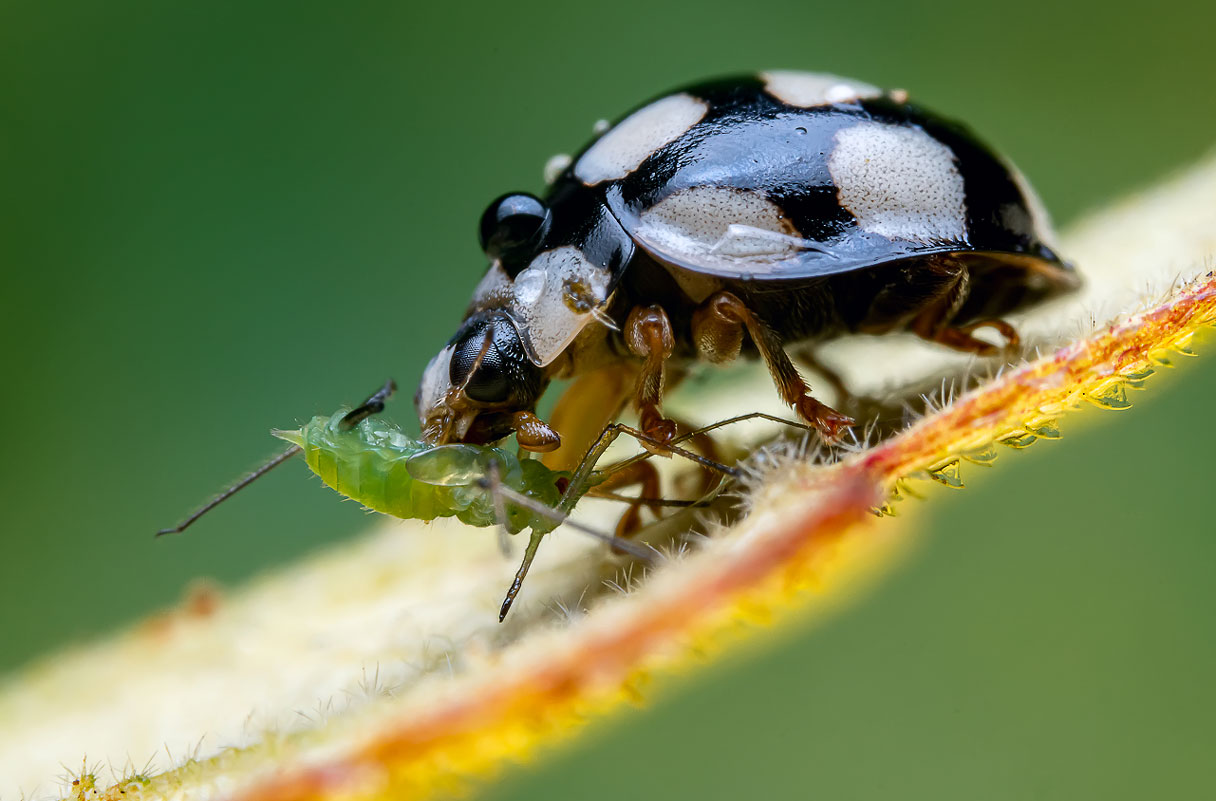October 28, 2025 | 07:17 GMT +7
October 28, 2025 | 07:17 GMT +7
Hotline: 0913.378.918
October 28, 2025 | 07:17 GMT +7
Hotline: 0913.378.918

Once ladybird beetles evolved the same mutations in aphids that made them immune to plant toxins, they could eat the toxin-filled aphids.
More than 20 years ago, scientists pinpointed a mutation that helped insects resist insecticides. It’s not a new trick, a new study finds: Over the past 300 million years, moths, butterflies, mealy bugs, aphids, and even ladybird beetles have employed the same genetic adaptation to sidestep the deadly chemical defenses deployed by plants. Skirting such dangers may have even paved the way for these groups of insects to become very diverse, assert the authors of the study, published today in Nature Ecology & Evolution.
“It’s an extremely nice story,” says Richard ffrench-Constant, a molecular natural historian at the University of Exeter who was not involved with the work. This modification “is something that is very, very deep [in time].”
In the 1980s, researchers determined that some 60% of cases of insect and mite resistance to pesticides was due to their ability to withstand a class of chemicals known as cyclodienes, which had been introduced several decades earlier. In 1990, ffrench-Constant began to home in on the gene that protected wild fruit flies against these chemicals. Three years later, his team demonstrated that the flies owed their protection to a single mutation affecting a protein known as a GABA receptor.
In cells, these receptors are landing zones for a nerve signal called GABA. In people, barbiturates and other psychoactive and analgesic substances bind to this receptor, “[making] people feel up or down,” ffrench-Constant explains. In insects, GABA tamps down their activity, even putting them to sleep. But critically, insecticides and other toxins also bind with this receptor.
More recently, Jia Huang, an insect physiologist at Zhejiang University, was studying the effects of plant toxins on insect nervous systems when he noticed that many aphid species had this same mutation, even when they had not been exposed to the insecticides that spur the evolution of resistance. Perplexed, he and his students scoured thousands of publicly available insect genomes in search of more instances of the gene variant. They were surprised at how frequently this mutation, along with a few closely related ones, turned up. Many genomes featured multiple copies of these genes, suggesting they were important long before humanmade pesticides appeared.
Working with evolutionary biologist Noah Whiteman at the University of California, Berkeley, the researchers used the evolutionary relationships between these insects to figure out when these genes appeared. What they discovered, ffrench-Constant says, was “a classic arms race.” Several times over the past 300 million years, the insects appear to have gained the mutations in response to plants evolving new types of chemical defenses that deterred insects from feasting on the plants.
For example, the first gymnosperms, which include spruce, pine, and cycads, evolved toxins called terpenoids. In response, the ancestors of aphids and other early sap-feeding insects evolved ways to resist those chemicals. Then, by exploiting these new host plants, these insects were able to thrive and diversify.
About 1 million years later, ladybugs—also known as ladybird beetles—evolved their own changes to their GABA receptors. Before that adaptation, they would eat mold growing on aphid excrement, but the aphids themselves (and their relatives) were too toxic for consumption because they were full of terpenoids from their sap-heavy diets. The ladybugs could snack on aphids with impunity, however, once their GABA receptors mutated.
Finally, 94 million years ago, modern flowering plants were just starting to diversify. At the same time, the GABA receptor in a group of moths that today accounts for about one-third of existing species duplicated and evolved a similar mutation—allowing the moths to safely digest these brand new food sources.
ffrench-Constant says these scenarios are compelling but ultimately represent the researchers’ best guesses as to why these mutations occurred when they did. “Without a time machine, we can’t really go back in time to check whether this is really the case,” he says.
But Whiteman is confident the findings reveal something fundamental about the way life evolves. “It is this antagonistic dynamic between plants and their insects that has driven the diversity of these groups,” he says, likening it to similar arms races seen in predator-prey and parasite-host relationships. “You see evolution does it again, and again, and again.”
(Science)

(VAN) Commitments and next steps to be presented at the World Urban Forum in Baku 2026.

(VAN) The Agriculture Department will reopen about 2,100 county offices all across the country Thursday despite the ongoing government shutdown to help farmers and ranchers get access to $3 billion of aid from existing programs.

(VAN) This year’s Forum was attended by several global leaders and included the celebration of a historic World Food Day marking FAO’s 80th anniversary.

(VAN) Could the boreal forest be less fragile than we think? Contrary to the predictions of models that forecast its rapid decline in favour of temperate maple forests, the ecological history of the boreal forest is showing surprising resilience.

(VAN) Why do some chocolate bars exhibit complex flavor notes like floral, caramel, and gentle woody, while others taste harsh, bitter, and astringent?

(VAN) Long-term progress in the battle against Salmonella in laying hens has been confirmed in the latest annual publication by the UK government.

(VAN) China's exports of rare earth magnets fell in September, reigniting fears that the world's top supplier could wield its dominance over a component key for U.S. defence firms and makers of items from cars to smartphones as leverage in trade talks.